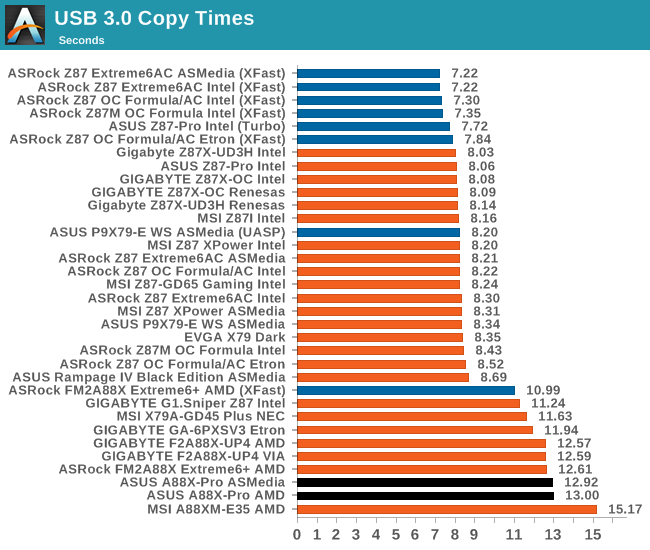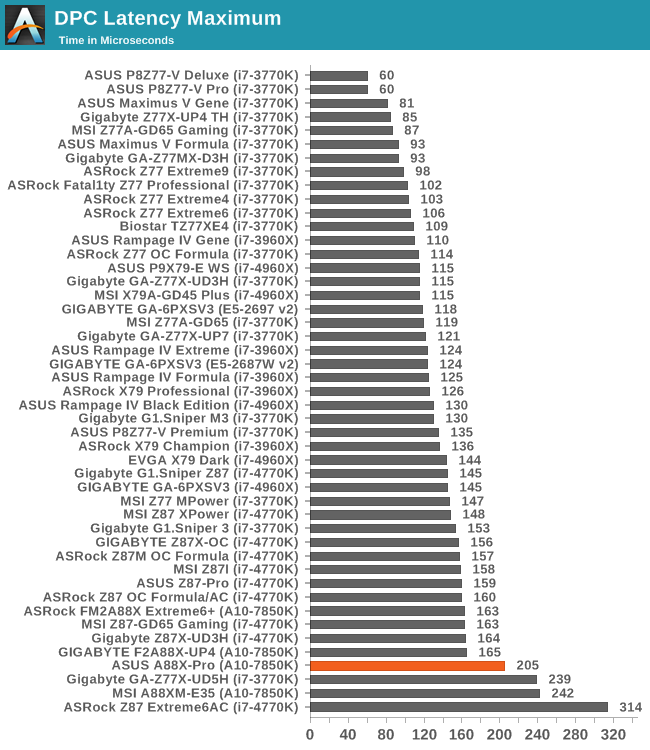ASUS A88X-Pro Review: Kaveri, Kaveri, Quite Contrary
by Ian Cutress on April 22, 2014 11:59 AM EST- Posted in
- Motherboards
- AMD
- Asus
- Kaveri
System Benchmarks
Rightmark Audio Analyzer 6.2.5
The premise behind Rightmark:AA is to test the input and output of the audio system to determine noise levels, range, harmonic distortion, stereo crosstalk and so forth. Rightmark:AA should indicate how well the sound system is built and isolated from electrical interference (either internally or externally). For this test we connect the Line Out to the Line In using a short six inch 3.5mm to 3.5mm high-quality jack, turn the OS speaker volume to 100%, and run the Rightmark default test suite at 192 kHz, 24-bit. The OS is tuned to 192 kHz/24-bit input and output, and the Line-In volume is adjusted until we have the best RMAA value in the mini-pretest. We look specifically at the Dynamic Range of the audio codec used on board, as well as the Total Harmonic Distortion + Noise.
Dynamic Range of the ASUS A88X-Pro


The THD+N results from the A88X-Pro are some of the best we have ever seen on a motherboard. Being the only A88X motherboard we have tested with an ALC1150, this seems to make a difference.
USB Backup
For this benchmark, we run CrystalDiskMark to determine the ideal sequential read and write speeds for the USB port using our 240 GB OCZ Vertex3 SSD with a SATA 6 Gbps to USB 3.0 converter. Then we transfer a set size of files from the SSD to the USB drive using DiskBench, which monitors the time taken to transfer. The files transferred are a 1.52 GB set of 2867 files across 320 folders – 95% of these files are small typical website files, and the rest (90% of the size) are the videos used in the WinRAR test. In an update to pre-Z87 testing, we also run MaxCPU to load up one of the threads during the test which improves general performance up to 15% by causing all the internal pathways to run at full speed.


DPC Latency
Deferred Procedure Call latency is a way in which Windows handles interrupt servicing. In order to wait for a processor to acknowledge the request, the system will queue all interrupt requests by priority. Critical interrupts will be handled as soon as possible, whereas lesser priority requests, such as audio, will be further down the line. So if the audio device requires data, it will have to wait until the request is processed before the buffer is filled. If the device drivers of higher priority components in a system are poorly implemented, this can cause delays in request scheduling and process time, resulting in an empty audio buffer – this leads to characteristic audible pauses, pops and clicks. Having a bigger buffer and correctly implemented system drivers obviously helps in this regard. The DPC latency checker measures how much time is processing DPCs from driver invocation – the lower the value will result in better audio transfer at smaller buffer sizes. Results are measured in microseconds and taken as the peak latency while cycling through a series of short HD videos - less than 500 microseconds usually gets the green light, but the lower the better.

Somewhat uncharacteristically ASUS’ DPC latency on the A88X-Pro hits above 200. In our test we were seeing spikes up to 205, with the average being lower. We could not find the source of the spikes.











34 Comments
View All Comments
mikato - Wednesday, April 23, 2014 - link
"ASUS has suggested that my review CPU from AMD is from an initial batch of A10-7850K which may have higher-than-retail leakage issues. We are currently investigating this further.""Signs may point towards early batch of Kaveri processors that draw higher current, or the silicon lottery."
Wow, does this mean you are going to rerun the power consumption numbers from the Kaveri review and give us new graphs? You really should.
"we take a series of 170 images in various sizes and formats and convert them all into 640x480 .gif files, maintaining the aspect ratio"
I'm just curious how that's possible? Do you use blank bars on the sides? Or do they all have the same length:width ratio to match 640x480 to begin with?
Hrel - Thursday, April 24, 2014 - link
"A side note: we are looking into the restarting flaw that seems to occur during our specialised benchmark under high CPU load. Signs may point towards early batch of Kaveri processors that draw higher current, or the silicon lottery. We need to get a newer one in to retest our Photoscan benchmark."The fact that you still recommended this motherboard, despite the above quote, makes this sites recommendations meaningless. You're AMD bias is only going to do harm, not good. Please stop yourselves from showing such obvious favoritism. AMD platforms are less stable than Intel, this is a long known fact.
silverblue - Sunday, April 27, 2014 - link
And this is the sort of FUD that AMD and its customers have to put up with.Haravikk - Sunday, April 27, 2014 - link
It's nice to see AMD still getting some good performance motherboards. This said, I have to say I really prefer the layout of the ASRock FM2A88-ITX+ motherboard, and wish more motherboards would do something similar. While it does get a little tight on the CPU cooler to have the memory angled "horizontally" towards the "top" of the motherboard, it just gives much better airflow and cooler RAM in general; I wish more manufacturers would do this, and just leave cooler manufacturers to adapt.